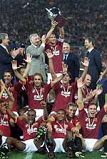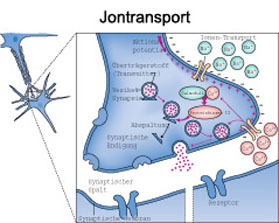| 20/03/2005 9:15:00 pm |
| QRS In Professional Sport |
 |
| Quantronic Resonance System (QRS)
In Professional Sport
Dr. Med. ML Baude Clinical Support Manager
|
 |

|
| |
Overview
QRS can be compared with John Wayne, the quietly spoken cowboy, who belied his outward persona to win the war (and also the girls). QRS doesn't vibrate or make noise but it is an extremely powerful health management tool when used in professional sport. QRS works quietly at the cellular level to create a range of positive outcomes.
The value of a successful team exceeds the sum of all its parts so contemporary sports management takes a holistic approach to the team and develops strategies to address each of the many "parts". QRS is a holistic, natural, non-invasive and side-effects free solution to many of the "challenges" that confront the sports management team. Specifically, QRS significantly improves:
· Teamwork
· Ability to train
· Nutrition
· Physical preparation for competition
· Psychological preparation for competition
· Endurance
· Physical skills
· Recovery from injuries
· Level of absenteeism
· Team management
An essential benefit of QRS is its compatibility with every other modality and management strategy to provide a value added result. It is truly adjunctive.
|
 |
|
 |

|
| |
QRS- Aim in Professional Sport
The aim of QRS is to create significant improvements in performance such that the management, team, and individuals achieve their short and long term goals (tactical and strategic).
Application and Cost Effectiveness
Team and player income derived from professional sport is outstanding but only the fair result for many years of dedication and pain by both participants and management. QRS costs less than the income from one game, is insignificant across a season and miniscule over a sportsmans professional career. There is a 2-year warranty and the product should last many years.
QRS should be deployed at the personal level (including team management) for "home use" as well as a quantity for the training/game preparation room.
QRS should be applied twice daily (8 minutes each session) and more often under circumstances discussed below.
The Sum of the Parts
Teamwork
A potentially great player only achieves greatness as part of a great team. The interdependence of players is well understood and no longer challenged by players who once thought they were the team. The changes that can be expected across the individual team members (and management) with QRS will be reflected at the team (including management) level through better team spirit, harmony, focus / sense of purpose, reduced absenteeism and success in competition.
Ability to train
Seasons get longer, personal commitments greater and the need for "consistent top performance" makes the life of a professional sportsman tough. Forget about personal life because surviving requires 24 hour a day professional concentration. QRS will do a lot to improve the player's readiness for training.
Elite sportsmen repeatedly push both body and spirit to the limit and beyond with the result that damage is constantly caused to soft tissue and bones, metabolism is impaired and this results in nutritional deficiency and a reduced immune system.
How does QRS improve readiness? To answer that question it is necessary to understand what happens during the course of an 8-minute QRS therapy:
· The heart effect - The heart beat slows (relaxes), frequency decreases
· Blood pressure effect - Blood pressure decreases (normalises)
· Blood flow speed - The blood flows faster
· Blood viscosity - The viscosity of the blood decreases (blood thins)
· Respiratory volume - Humans immediately breathe more deeply
· Capillary dilation - Nitrogen Monoxide, the vaso-dilator, is produced (on control unit settings up to 5) which dilates capillaries
· Oxygen uptake - More oxygen adheres to the haemoglobin as blood flows through the lungs.
· Oxygen stripping rate - The amount of oxygen stripped from the haemoglobin at the capillary level is increased.
· Brain wave stimulation - brain wave patterns are altered
· Transmembrane potential - QRS restores the transmembrane potential across the cell wall. This increases energy and improves metabolism.
· Ion transport - Ions (both positive and negative) are transferred from the electrolytic fluids into adjacent cells. Nutrient uptake is improved.
If QRS is used once only, the above effects quickly wear off and the benefits are not realised. QRS has been developed for long-term use on a daily basis and the above effects therefore compound and produce longer lasting effects.
The player's readiness for training and competition will be improved because:
· Peripheral circulation will move more oxygenated blood to the site of soft tissue injuries and bone damage. This constant action to repair injuries before they become evident (felt) will reduce the number of injuries that reach the level where reduced performance is incurred.
· Serious injuries will repair in 50% of the normally budgeted time. For example, the Newcastle Knights Rugby League Team (one of the 12 professional teams in the Australian competition) has found that QRS will reduce the time to get a player with a broken pinned hand onto the field from 7 to 3 or 4 weeks.
· Energy is restored and metabolism improves. There is a better uptake of nutrients and discharge of wastes.
· The physical results of drug and alcohol abuse will be reduced through enhanced ion transport and metabolism.
· The 3Hz Delta frequency reduces stress and creates a feeling of wellbeing on low QRS settings whilst the 23Hz frequency increases vigour. These effects on the mind will relax and focus the sportsman and provide ?clear headedness?.
· The immune system is supported which results in lower incidence of colds and flu.
|
 |
|
 |

|
| |
Nutrition
Such highly tuned human organisms are very difficult to balance nutritionally. QRS, especially through its effects on the transmembrane potential and ion transport, facilitates the nutritional balancing. Nutrients are more quickly absorbed and metabolism becomes more efficient.
Physical preparation for competition
The need to warm up before competition is reinforced with sportsmen but it is impossible to warm up to the extent of being immediately capable of sustaining the level of combat required in professional sport. It is likely that much of the soft tissue damage is incurred in the first few minutes of competition.
QRS applied immediately before competition dilates capillaries and increases the speed of flow of blood with increased oxygen at lower viscosity that is better stripped by the capillaries. The competitor is therefore better prepared and warmed up.
Psychological preparation for competition
Elite sport is a psychologically demanding challenge that is handled by each person differently:
· Rookies and highly-strung competitors may burn a lot of energy before competition through the stress of the impending battle (people vomit). Performance can only suffer.
· Experienced players may need to be "invigorated" before the game to give them a sense of energy and urgency.
· All players benefit from a mind settling effect that focuses the mind on the task at hand.
When used on low settings (below 4), QRS has a relaxing effect with the 3 Hz Delta frequency and tense players and players with a problem of focus will experience improvement.
When used on higher settings (5-7), QRS invigorates with the 23 Hz Beta frequency more important in the amplitude window. Energy and focus are improved.
Endurance
The recent British and Irish Lions Rugby tour of Australia (June-July 2001) was evenly matched with The Lions winning the first game and Australia winning the second game. The final, in front of 84,000 people, was a cliffhanger with the lead changing six times in the first three quarters. Australia won in the last quarter 29 to 23. The Lions admitted that they ran out of steam in the last ten minutes. It was the first series defeat for the Lions in 106 years.
QRS improves endurance by increasing:
· the volume of blood of lower viscosity,
· the volume of oxygen,
· the ability of the capillaries to strip oxygen, and
· the repair of soft tissue injuries.
It is necessary to use QRS daily for at least two months to create the longer-term effects that lead to improved endurance.
Physical Skills
It is quite logical that a clear mind ensures a high level of physical skills. QRS improves the availability of the competitor to train and therefore to practise physical skills without part of the brain focusing on pain in parts of the body. Similarly, improved endurance leads to better physical performance.
Recovery from injuries
The level of physical intensity in elite sport ensures that soft tissue is constantly torn. QRS moves oxygenated blood to soft tissue capillaries, reducing the incidence of soft tissue injuries that become serious. Serious injuries are repaired in 50% of the normal time.
Contact sports in particular create micro-fractures in bones. QRS causes vaso and capillary dilation, so helping to speed up the process of callus formation. Within the bone itself, the pulsed electromagnetic field causes the induction of small eddy currents in the trace elements, which in turn purify and strengthen the crystal structures. These have the same effect as the stress-induced voltages caused by the alpha quartz and as such, attract bone cells to the area under treatment. This can therefore accelerate the bone healing process to allow earlier mobilisation and eventual full union. Ligaments and tendons are affected in similar ways to solid bone by pulsed electromagnetic therapy, since they are un-calcified bone structures in themselves. An Australian women's rowing team suffered from stress fractures to the vertebra until QRS was introduced on a programmed basis.
Team managementThere is nothing more demanding than team management. Competitors at least have the opportunity to "blow off steam". Losing teams often comprise more talented players but are let down at the management level. Team management needs to apply QRS as intensively as competitors with the intention of:
· Decreasing stress (and depression when things aren't going right).
· Improving focus on the challenges ahead.
· Increasing energy.
· Improving the immune system to ward off colds and viruses.
· Improving personal interaction with players and staff.
|
 |
| Published by Kai Boman den 20/03/2005 9:15:00 pm () |
| |


